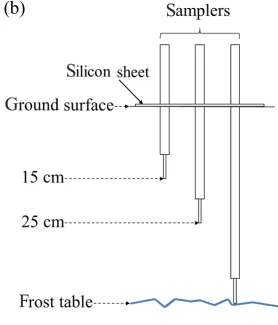Bromide Tracer Studies Quantify Vertical and Horizontal Flow in Low- and High-centered Polygons
- Evaluate using novel bromide tracers to identify the roles of vertical and horizontal water fluxes in the subsurface of polygonal landscapes and provide new insights and data to test and calibrate hydrological models.
- Field-scale investigations using a conservative tracer were conducted at the Barrow Environmental Observatory (BEO) near Utqiaġvik, AK.
- Sampler arrays placed in polygon centers, rims, and troughs were used to monitor tracer concentrations.
- Tracer breakthrough curves revealed slow movement of water with preferential flow downward to the frost table.
- Soil permeabilities were estimated and a conceptual model developed that showed how solutes are transported within ice-wedge polygons.
- Results are now being incorporated into regional and global models of catchment hydrology.
Wales, NA, JD Gomez-Velez, BD Newman, CJ Wilson, B Dafflon, TJ Kneafsey, F Soom, and SD Wullschleger. 2020. Understanding the relative importance of vertical and horizontal flow in ice-wedge polygons, Hydrology and Earth System Sciences, 24:1109-1129. https://doi.org/10.5194/hess-24-1109-2020
This research was supported by the Director, Office of Science, Office of Biological and Environmental Research of the US Department of Energy under Contract No. DE-AC02-05CH11231 as part of the Next-Generation Ecosystem Experiments (NGEE Arctic) project.
For more information, please contact:
Brent Newman


